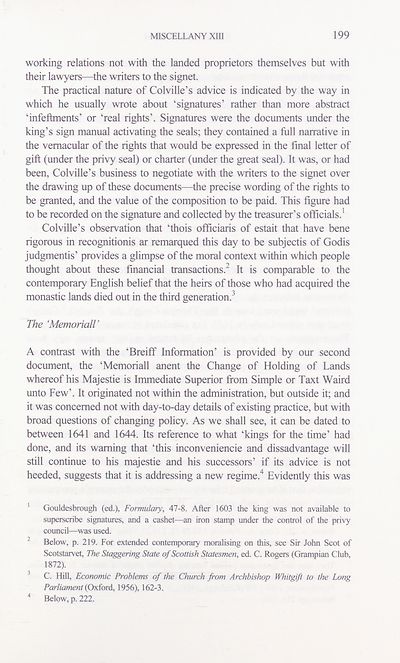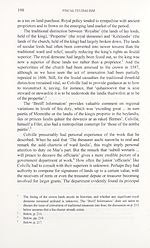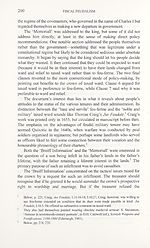Series 5 > Miscellany [of the Scottish History Society] XIII
(214) Page 199
Download files
Complete book:
Individual page:
Thumbnail gallery: Grid view | List view

MISCELLANY XIII
199
working relations not with the landed proprietors themselves but with
their lawyers—the writers to the signet.
The practical nature of Colville’s advice is indicated by the way in
which he usually wrote about ‘signatures’ rather than more abstract
‘infeftments’ or ‘real rights’. Signatures were the documents under the
king’s sign manual activating the seals; they contained a full narrative in
the vernacular of the rights that would be expressed in the final letter of
gift (under the privy seal) or charter (under the great seal). It was, or had
been, Colville’s business to negotiate with the writers to the signet over
the drawing up of these documents—the precise wording of the rights to
be granted, and the value of the composition to be paid. This figure had
to be recorded on the signature and collected by the treasurer’s officials.1
Colville’s observation that ‘thois officiaris of estait that have bene
rigorous in recognitionis ar remarqued this day to be subjectis of Godis
judgmentis’ provides a glimpse of the moral context within which people
thought about these financial transactions.2 It is comparable to the
contemporary English belief that the heirs of those who had acquired the
monastic lands died out in the third generation.3
The ‘MemorialT
A contrast with the ‘Breiff Information’ is provided by our second
document, the ‘Memoriall anent the Change of Holding of Lands
whereof his Majestie is Immediate Superior from Simple or Taxt Waird
unto Few’. It originated not within the administration, but outside it; and
it was concerned not with day-to-day details of existing practice, but with
broad questions of changing policy. As we shall see, it can be dated to
between 1641 and 1644. Its reference to what ‘kings for the time’ had
done, and its warning that ‘this inconveniencie and dissadvantage will
still continue to his majestie and his successors’ if its advice is not
heeded, suggests that it is addressing a new regime.4 Evidently this was
1 Gouldesbrough (ed.). Formulary, 47-8. After 1603 the king was not available to
superscribe signatures, and a cashet—an iron stamp under the control of the privy
council—was used.
2 Below, p. 219. For extended contemporary moralising on this, see Sir John Scot of
Scots tarvet. The Staggering State of Scottish Statesmen, ed. C. Rogers (Grampian Club,
1872).
3 C. Hill, Economic Problems of the Church from Archbishop Whitgifi to the Long
Parliament (Oxford, 1956), 162-3.
4 Below, p. 222.
199
working relations not with the landed proprietors themselves but with
their lawyers—the writers to the signet.
The practical nature of Colville’s advice is indicated by the way in
which he usually wrote about ‘signatures’ rather than more abstract
‘infeftments’ or ‘real rights’. Signatures were the documents under the
king’s sign manual activating the seals; they contained a full narrative in
the vernacular of the rights that would be expressed in the final letter of
gift (under the privy seal) or charter (under the great seal). It was, or had
been, Colville’s business to negotiate with the writers to the signet over
the drawing up of these documents—the precise wording of the rights to
be granted, and the value of the composition to be paid. This figure had
to be recorded on the signature and collected by the treasurer’s officials.1
Colville’s observation that ‘thois officiaris of estait that have bene
rigorous in recognitionis ar remarqued this day to be subjectis of Godis
judgmentis’ provides a glimpse of the moral context within which people
thought about these financial transactions.2 It is comparable to the
contemporary English belief that the heirs of those who had acquired the
monastic lands died out in the third generation.3
The ‘MemorialT
A contrast with the ‘Breiff Information’ is provided by our second
document, the ‘Memoriall anent the Change of Holding of Lands
whereof his Majestie is Immediate Superior from Simple or Taxt Waird
unto Few’. It originated not within the administration, but outside it; and
it was concerned not with day-to-day details of existing practice, but with
broad questions of changing policy. As we shall see, it can be dated to
between 1641 and 1644. Its reference to what ‘kings for the time’ had
done, and its warning that ‘this inconveniencie and dissadvantage will
still continue to his majestie and his successors’ if its advice is not
heeded, suggests that it is addressing a new regime.4 Evidently this was
1 Gouldesbrough (ed.). Formulary, 47-8. After 1603 the king was not available to
superscribe signatures, and a cashet—an iron stamp under the control of the privy
council—was used.
2 Below, p. 219. For extended contemporary moralising on this, see Sir John Scot of
Scots tarvet. The Staggering State of Scottish Statesmen, ed. C. Rogers (Grampian Club,
1872).
3 C. Hill, Economic Problems of the Church from Archbishop Whitgifi to the Long
Parliament (Oxford, 1956), 162-3.
4 Below, p. 222.
Set display mode to:
![]() Universal Viewer |
Universal Viewer | ![]() Mirador |
Large image | Transcription
Mirador |
Large image | Transcription
Images and transcriptions on this page, including medium image downloads, may be used under the Creative Commons Attribution 4.0 International Licence unless otherwise stated. ![]()
| Scottish History Society volumes > Series 5 > Miscellany [of the Scottish History Society] XIII > (214) Page 199 |
|---|
| Permanent URL | https://digital.nls.uk/127316097 |
|---|
| Description | Over 180 volumes, published by the Scottish History Society, containing original sources on Scotland's history and people. With a wide range of subjects, the books collectively cover all periods from the 12th to 20th centuries, and reflect changing trends in Scottish history. Sources are accompanied by scholarly interpretation, references and bibliographies. Volumes are usually published annually, and more digitised volumes will be added as they become available. |
|---|


